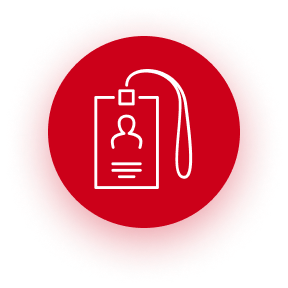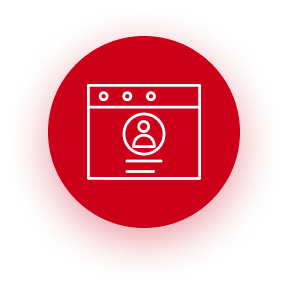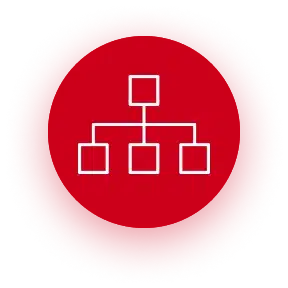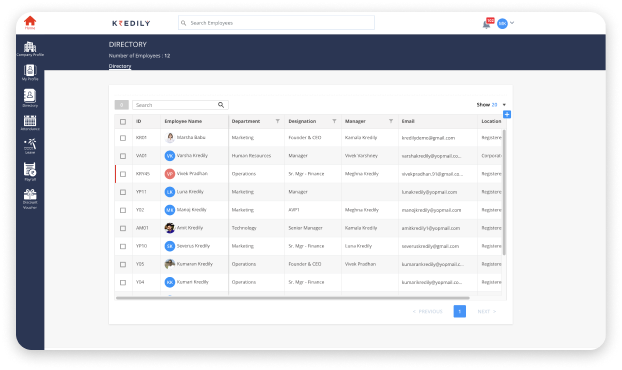Employee directory- Powering your employee, empowering your business.
Now get the best employee experience with our robust HR software!
Existing User? Sign In
Now get the best employee experience with our robust HR software!
Existing User? Sign In

Simplify employee directory management and access employee details effortlessly. Obtain comprehensive information with a single click, including the employee's name, job title, email address and office location.

Utilize the search feature to easily locate specific employees based on name, job title, or other criteria. Additionally, you can review the details and count of both active and inactive employees.

Custom fields empower HR administrators to include information such as employee ID, status, and emergency contacts. Bulk editing capabilities enable HR to efficiently update department, status, designation, reporting manager for multiple employees at once.

User profiles enable employees to input personal information, including profile pictures, bios, professional skills, marital status, and more. This feature facilitates easy access to colleague details and fosters better connectivity within the organization

A directory visually displays the company's hierarchy, featuring employee names, departments, and department heads. It offers a clear representation of reporting relationships within the organization.

Our employee directories are accessible on mobile devices, enabling employees to access contact information even when they're away from their desks.
An employee directory holds significant importance in managing employee information due to its ability to centralize data, enhance accuracy, provide accessibility, ensure security, and boost productivity. By leveraging an employee directory, organizations can effectively manage employee data, streamline HR processes, and adhere to data privacy regulations, thus reaping substantial benefits.

An employee directory, also known as a staff directory or corporate directory, is a comprehensive database or listing of all the employees within an organization. It serves as a centralized resource that provides essential contact and organizational information about each employee.
The employee directory typically includes details such as:
Employee Names: The full names of all employees listed alphabetically or by department.
Contact Information: Employee phone numbers, email addresses, and sometimes physical office locations.
Job Titles and Departments: The roles and responsibilities of each employee, along with the department they belong to.
Profile Pictures: Some employee directories may include profile pictures to help identify individuals visually.
Reporting Structure: Information about the organizational hierarchy, such as who reports to whom.
Additional Details: Depending on the organization's needs, the directory might include other relevant information, such as work experience, educational background, and skills.
The employee directory is often accessible to all employees within the organization through an internal portal, intranet, or HRMS (Human Resource Management System). It facilitates communication and collaboration by allowing employees to quickly find and contact colleagues, managers, or other team members. The directory is a useful resource for onboarding new employees, coordinating projects, and fostering a sense of community within the organization. Additionally, it simplifies the process of reaching out to the right person for specific tasks or queries, thus improving overall workflow and productivity.
In the digital age, an employee directory remains essential for efficient communication and collaboration within organizations. With a centralized database of employees' contact information, job roles, and reporting structures, it enables quick access to the right people for projects, queries, or emergencies. The directory fosters a sense of community, eases onboarding for new hires, and enhances teamwork. In remote or hybrid work environments, where face-to-face interactions are limited, the employee directory becomes even more critical in maintaining seamless connectivity and productivity. Ultimately, it streamlines communication, facilitates knowledge sharing, and contributes to a cohesive and productive workplace environment.
An employee directory is essential as it provides a centralized, accessible, and up-to-date source of information about all employees in an organization. It enables efficient communication and collaboration by helping employees quickly find and contact colleagues, managers, or team members. The directory streamlines workflows, enhances productivity, and fosters a sense of community within the organization. In today's dynamic work environment, with remote and distributed teams becoming more common, the employee directory becomes even more critical for maintaining seamless connectivity and ensuring employees have the necessary resources to work together effectively. Overall, it promotes better teamwork, reduces communication barriers, and improves overall organizational efficiency.
The employee directory serves various essential purposes within an organization. Some of the most common uses include:
Contact Information: Employees can quickly find contact details like phone numbers, email addresses, and office locations of their colleagues and team members for smooth communication.
Collaboration and Networking: The directory fosters networking and collaboration by helping employees connect with colleagues from different departments or locations.
Organizational Hierarchy: It displays the reporting structure, helping employees understand their chain of command and identify key decision-makers.
Onboarding: New employees use the directory to familiarize themselves with their team members and learn about their roles and responsibilities.
Project Management: When forming project teams, managers use the directory to identify suitable team members with the required skills and expertise.
Emergency Contacts: In case of emergencies, the directory provides access to important contact information for employees and their designated emergency contacts.
Company Events and Announcements: The directory aids in disseminating company-wide announcements, updates, and invitations to events.
Recognition and Acknowledgment: Employees can search for and acknowledge the contributions of their colleagues, enhancing a culture of appreciation.
Compliance and Auditing: The employee directory ensures accurate record-keeping and compliance with regulatory requirements.
Human Resource Management: HR personnel use the directory to manage employee information and update records as needed.
By providing a comprehensive and easily accessible repository of employee data, the directory streamlines communication, enhances teamwork, and contributes to an efficient and connected workplace environment.
An employee directory provides several benefits for employees, including easy access to colleague information for efficient communication and networking opportunities. It streamlines onboarding by helping new hires understand the organizational structure. Enhanced collaboration is facilitated by forming project teams with the right expertise. The directory encourages recognition and appreciation among peers. It increases productivity by saving time finding contacts. In emergencies, employees can quickly access important contact information. Personalization of profiles allows others to connect easily. Organizational transparency is promoted by displaying reporting structures. Overall, the employee directory empowers employees, fostering a positive work environment and improving communication, collaboration, and productivity.
An employee directory offers numerous benefits for businesses, contributing to improved efficiency, communication, and overall organizational effectiveness. Some of the key advantages include:
Efficient Communication: The directory enables quick access to contact information, streamlining communication within the organization and facilitating effective collaboration among employees.
Enhanced Collaboration: Businesses can form project teams more efficiently by identifying employees with the right skills and expertise through the directory, leading to improved project outcomes.
Onboarding and Integration: New employees can use the directory to learn about their colleagues and managers, helping them integrate into the organization more smoothly.
Networking and Relationship Building: The directory promotes networking opportunities among employees, fostering a sense of community and facilitating relationship building within the organization.
Improved Productivity: With easy access to colleague information, employees can save time and effort in locating the right contacts, leading to increased productivity.
Organizational Transparency: The directory showcases reporting structures, promoting transparency and accountability within the organization.
Recognition and Appreciation: The directory allows employees to acknowledge the contributions of their peers, fostering a culture of recognition and appreciation.
Facilitates HR Management: HR personnel can use the directory to manage employee records and track changes in job roles and departments effectively.
Access to Emergency Contacts: In critical situations, businesses can use the directory to reach designated emergency contacts for employees.
Centralized Employee Information: Having a comprehensive employee directory creates a centralized repository of employee data, simplifying data management and record-keeping processes.
Overall, an employee directory contributes to a more connected, productive, and engaged workforce, enhancing the overall performance and success of the business.
A successful employee directory exhibits several key characteristics that contribute to its effectiveness and usefulness within an organization. Some factors that make an employee directory successful include:
Comprehensive and Accurate Data: A successful directory contains up-to-date and accurate information about all employees, ensuring that employees can rely on it for communication and collaboration.
User-Friendly Interface: An intuitive and easy-to-navigate interface allows employees to quickly find the information they need without unnecessary complexity or confusion.
Search and Filter Capabilities: Robust search and filtering options enable employees to find specific colleagues or teams based on various criteria, such as name, department, or job role.
Mobile Accessibility: A successful directory is accessible through mobile devices, enabling employees to access contact information on-the-go, especially in a remote or hybrid work environment.
Integration with Communication Tools: Integration with email clients, instant messaging apps, or collaboration platforms enhances seamless communication and quick access to contacts.
Security and Privacy: A secure directory with appropriate access controls ensures that sensitive employee information remains confidential and protected from unauthorized access.
Regular Updates: Regularly updating the directory with changes in employee roles, contact information, or reporting structures ensures its relevance and accuracy.
Integration with HRMS or Intranet: Integration with the organization's HRMS or intranet platform provides a seamless flow of data and ensures consistency across various systems.
Customizable Fields: The ability to customize fields and information based on the organization's needs allows tailoring the directory to specific requirements.
Feedback and Improvement Mechanism: A successful directory actively seeks feedback from users and implements improvements based on user suggestions to enhance usability and functionality.
Support and Training: Providing adequate support and training for employees on how to use the directory ensures its effective adoption and utilization.
By incorporating these elements, an employee directory can become a valuable and successful tool that fosters efficient communication, collaboration, and employee engagement within the organization.
An employee database is a structured collection of information containing details about an organization's employees. It includes data such as names, contact information, job titles, departments, employment history, and other relevant employee-related information. The database is used for HR management, payroll, reporting, and other organizational purposes.
Employee database software is a specialized software application designed to manage and store employee-related information in a structured and organized manner. It provides a centralized repository for HR data, including employee profiles, contact details, job roles, performance records, attendance, and more. Employee database software streamlines HR processes, facilitates easy retrieval of information, and enables efficient HR management, payroll processing, reporting, and compliance with employment regulations. It is a crucial tool for businesses and organizations to maintain accurate employee records and optimize human resource management.
Key Takeaways about Employee Directory Software:
Employee Directory Software is a centralized database that contains essential information about an organization's employees, such as contact details, job roles, and reporting structures.
It improves communication and collaboration by providing quick access to colleague information and fostering networking opportunities within the organization.
User-friendly interfaces, search capabilities, and mobile accessibility are essential features for effective employee directory software.
Integration with communication tools and HR systems enhances data flow and streamlines HR management processes.
Strong security measures are crucial to protect sensitive employee data and maintain confidentiality.
Bottom Line: Employee Directory Software is a valuable tool that streamlines HR processes, enhances organizational communication, and fosters a connected and productive work environment. By providing easy access to employee information, it contributes to efficient collaboration and improved HR management. Its user-friendly features and security measures make it an essential asset for modern organizations seeking better employee engagement and operational efficiency.
As a expanding non-profit organization, we were in search of an HR solution that could efficiently handle our fundamental HR operations without a significant financial burden. This is where Kredily came to our rescue! Kredily provided us with a Core HR suite completely free of charge. Its straightforward and user-friendly interface is remarkably intuitive and doesn't necessitate any training for implementation. It's quite noteworthy that in India, an HRIS company is offering such valuable services to clients without any cost.
We are highly content and delighted to have discovered Kredily as our HRMS partner. Throughout our collaboration, Kredily has cultivated a deep understanding of our unique vision and workflows, effectively aligning with our operations without causing any disruptions or complications on our end.
I discovered Kredily at precisely the moment when I began exploring HR tools and services for our operations. As a founder of a startup, I found myself dedicating a significant amount of time to manage attendance, leave, and payroll records. Kredily brought a higher level of transparency to our company's HR processes. The setup process was straightforward and well-guided. Personally, I appreciated the comprehensive information provided within the application about HR procedures.
We take immense satisfaction in our partnership with Kredily, which has proven immensely beneficial in streamlining our HRMS operations. For a small NGO such as ours, having access to a comprehensive solution on a single platform for managing employee records and authorization has been invaluable. This support has significantly contributed to our efforts in establishing our organization as an efficient institution.
Streamingo, a startup operating in the field of Artificial Intelligence, shares the common challenge with all bootstrapped startups in seeking a cost-effective HRMS solution. We were pleasantly amazed to discover that Kredily not only provides a user-friendly HRMS solution but also does so at zero cost. Kredily encompasses many of the features typically found in standard HRMS solutions and boasts remarkable simplicity and ease of use.